 |
||
|
||
| ||
The Intel i815 chipset has already replaced the 440BX due to the support of 133 MHz FSB, PC-133 memory and UDMA100 protocol. But there are still some niches where the 440BX based boards performs better. I mean dual-processor workstations and servers. As you might know, the performance boost may reach almost 100% with the second processor in some applications. But despite the support of dual-processor configurations by the Intel i815, such mainboards are very rare, while inexpensive alternative solutions come from Via - it is Apollo Pro 133A and Apollo 266 Pro chipset. It is possible that it's connected with the RAM being limited by 512 MBytes and with a lack of ECC support. Nevertheless, there is a company which launched a dual-processor variant of a board based on the Intel i815. This company is not among leaders in mainboard production. And the release of a dual processor board 6A815ED on the Intel 815E by Acorp was an unexpected event. The second SMP board 6A815EPD, on the 815EP, was introduced half a year later at Computex 2001. In fact, the Acorp's site contains information about two modifications of this board - 6A815EPD with IDE RAID and AC97 sound and 6A815EPD1 without them. But we have received an intermediate version - with RAID but without sound. Technical characteristics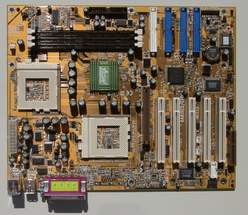
The board ships in a standard universal package, inside which you can find a manual, a CD with drivers and utilities (Norton Ghost and Norton Antivirus), cables (40-pin IDE, 34-pin FDD, 80-pin UDMA66/100) and a bracket for the second serial port. InstallationThe board has a standard size and fits excellently any case. Installation of the board can be prevented by long AGP video cards, but usual ones won't cause problems. Around sockets there are enough space for large cooling devices - squares of 80 X 80 mm are contoured right on the board indicating the position of a socket and planar details which must be not higher than 1.5 mm. The north bridge of the chipset is equipped with a small heatsink. Power supply can be difficult in some small cases, but the power cable is not going above important parts of the board. The connector for the second COM port is located successfully - it is tucked in between the fourth and fifth PCI slots on the edge of the board. IDE slots are positioned in the order: 2,1,4,3; of course, it doesn't affect operation of the board, but can cause confusion. IDE slots alternate with PCI slots, and despite the fact that installation of full-sized PCI cards is possible into three slots out of five, it will be inconvenient to mount IDE cables. In the version with AC97 sound you might face a problem of internal audio connectors which are located right under a video card. The BIOS chip is located on a mount. Near it you can find two LEDs: one for power supply of the board, the second flashes when the system is on. Winbond W83627HF-AW chip controls temperatures, fans and voltages. The processor temperatures are measured with built-in sensors. The board is equipped with a plastic transparent mount preventing from closing in case of careless mounting. Overclocking possibilitiesThe board offers two mechanisms for overclocking. The first one is changing of the processor's FSB among 66/100/133 MHz right on the board. The second is changing of the FSB frequency from BIOS. Unfortunately, in reality overclocking from FSB 100 MHz to 133 MHz doesn't work when rated means are used. The frequencies which can be chosen in the BIOS are:
When working with one processor we could reach 150 MHz of the FSB, with the ZDLabs CC Winstone 2001 running flawlessly. The Quake3 have shown the results higher by 12% than in case of the processor at the 133 MHz of the bus. After that I set FSB to 160 MHz to check how the "CPU safe mode" works in case of incorrect overclocking. But the board loaded the Windows 2000, and the system hung at the second minute of operation of the Quake3. Additional cooling of the chipset, memory, video, a clock generator didn't help. Then I tried the "CPU safe mode" switch but it refused to work, and I had to erase CMOS. At the next stage we tried to find out the highest frequency with two processors enabled. At 140 MHz of the FSB the Quake3 worked a couple of hours, and we raised the frequency by 5 MHz more. At 145 MHz the PC failed to load the OS. The Acorp 6A815EPD board is highly reliable. It goes on a par with the mainboard from ASUSTeK, Gigabyte, ABIT, SuperMicro. All tests were passed flawlessly. The board hung only twice - when one processor was removed and when FSB frequency was overlifted during overclocking. The Windows 2000 displayed a message saying that:  TestsSince we are interested in the operation speed in comparison with other boards on the Intel i815, and in the performance level in a dual-processor mode, we have chosen a uniprocessor board on the i815 and dual-processor boards on the VIA chipsets. The tests were carried out in the following configurations:
Tests:
Let's start with the ZDLabs Winstone 2001 which reveals the overall performance of the system in a uni-processor mode: 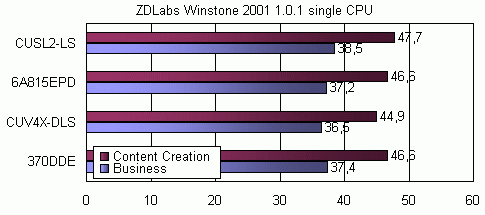 You can see that the Acorp board performs not worse than the mainboard from ASUS and SuperMicro. The 6A815EPD lags behind the CUSL2-LS only by a couple of percents. As you know, the ZDLabs Winstone 2001 doesn't use a dual-processor mode that is why we mustn't expect high performance boost on the SMP systems: 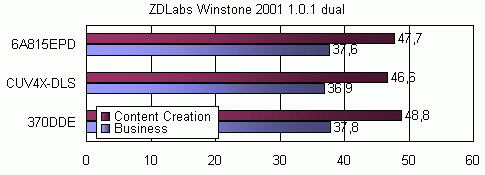 The i815 chipset takes a middle position between Apollo 133A and Apollo 266 Pro. The second test is BAPCO Sysmark 2000. It gives an average value in all applications. Let's start with one processor: 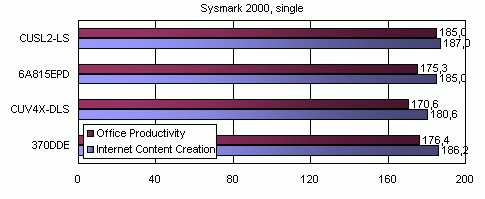 The 6A815EPD keeps at the level of the CUV4X-DLS and 370DDE. The ASUS CUSL2-LS outscored our hero by 5% in the Internet Content Creation. 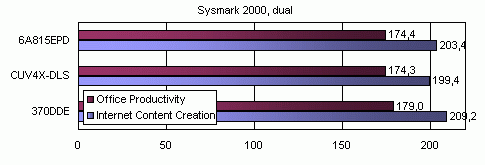 The results are very similar to the ZDLabs Winstone 2001 - the 6A815EPD with two processors is in the middle of the table between the CUX4X-DLS on Via Apollo Pro 133A and the 370DDE on Via Apollo 266 Pro. Let's look at the results obtained with the second processor in the Sysmark 2000 test. 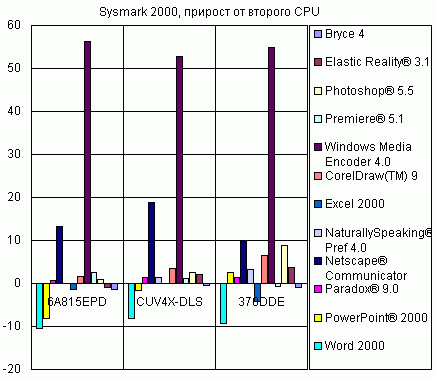 On the whole, the Acorp board behaves like other boards - we can see a substantial performance boost in the Netscape Communicator and Microsoft Media Encoder. But the speed falls unexpectedly in the PowerPoint 2000. The last test is Quake3 Arena, which works in the OpenGL and supports SMP. Since we are examining a speed of the the mainboard, we decided to display the results only in 640x480 since the differences are the most vivid in this resolution. Again we used three demo programs: crush, quaver and demo002, with the quality settings being normal, high and fast, respectively. Besides, in the fast and normal modes we set "16bit" instead of 'Default'. (On the diagram the names of the boards are shortened: CUV4X-DLS to CUV4X and CUSL2-LS to CUSL2). First go the results of the uni-processor configurations: 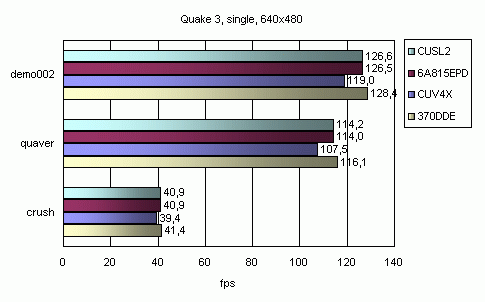 The 6A815EPD performs almost as the CUSL2-LS. Now comes the SMP: 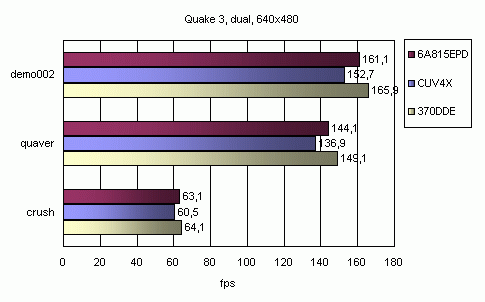 The positions of the boards don't change time and again. Now the speed increase with the second processor enabled: 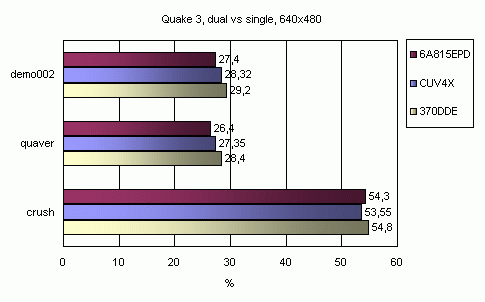 Here the 6A815EPD takes the second position only in the most laborious test for the processor - crush, in other tests it loses. ConclusionThe Acorp board shows excellent performance in all tests. Its reliability has nothing to complain about as well. In a uniprocessor mode the board falls behind the ASUSTeK CUSL2-LS just by a little margin. In all dual-processor tests the 6A815EPD takes a stable position between Via Apollo Pro 133A and Via Apollo 266 Pro based boards. But the differences are very slight. The Acorp board costs almost 30% less than similar products from ASUSTeK. The board is also cheaper than the Via Apollo Pro 133A based models. Highs:
Lows:
Write a comment below. No registration needed!
|
|
Platform · Video · Multimedia · Mobile · Other || About us & Privacy policy · Twitter · Facebook
Copyright © Byrds Research & Publishing, Ltd., 1997–2011. All rights reserved.